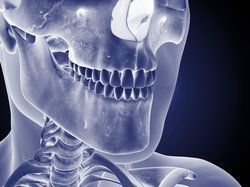Get in touch
(334) 277-3492
messages@jawdocs.net
(334) 277-3492
LOCATIONS PATIENT REGISTRATION
Bone Grafting Montgomery
Bone grafting at our Montgomery oral surgeons’ office helps refortify and strengthen weakened jawbones, whether to receive one or more dental implants or to improve a patient’s appearance and oral function. Traditionally, bone is taken from a donor source or from the patient’s own bone structure and surgically grafted to the affected area. With platelet-rich plasma (PRP), we can accelerate the healing process and promote bone growth to help patients heal and return to their lives sooner.
Lost Teeth and Jawbone Resorption
Human teeth and the jawbone that supports them share a complex, mutually beneficial relationship. The jawbone provides a stable foundation for teeth to endure the rigors of biting and chewing. Bite pressure stimulates teeth’s roots to facilitate healthy blood flow to the jawbone. When one or more teeth are lost, blood flow and the jawbone’s supply of nutrients diminish. Bone cells at the site immediately begin resorbing the vacated bone and distributing its nutrients where they’re most needed in the body. A dental implant can be inserted into the jawbone to replace the lost root and restore its function, but if enough jawbone structure has suffered, then it may not suffice to support prosthetic teeth roots.
Sinus Lift and Ridge-Augmentation
The success of dental implant placement lies in a process known as osseointegration—the jawbone fusing to the implant’s surface—which creates a lifelong replacement for lost teeth roots. If the lower jawbone, or mandible, is too thin or short to receive and support dental implants, then ridge-augmentation can improve the mandible’s integrity and prepare it for implant placement. To strengthen the upper jawbone, a sinus lift procedure can elevate the sinus membrane so that your oral surgeon can graft bone onto the sinus floor. For most patients, we may suggest platelet rich plasma for faster healing and improved results.
Platelet Rich Plasma (PRP)—Frequently Asked Questions
Until recently, PRP was restricted to hospital use only, mainly due to the amount of blood required (one unit) and the cost of separating platelets from the unit of blood. Now, however, we can harvest and produce an adequate supply of platelets from only 55cc of the patient’s own blood, making PRP easier to manage, handle, and administer for most oral and maxillofacial bone grafting procedures.
What is platelet rich plasma?
As the name implies, PRP is plasma (a by-product of blood) that’s rich in platelets, which form blood clots for healing and release growth factors (GF) into the wound for bone regeneration.
Is PRP safe?
Yes. The plasma is taken from the patient’s own blood, eliminating the disease transmission factor. The blood is extracted during the outpatient’s surgical procedure, and then spun down in the PRP centrifuge machine. The PRP typically forms and is ready for use within fifteen minutes.
What advantages does PRP offer?
Aside from safety and faster healing, PRP makes bone grafting more convenient, with a higher chance of success. Since only 55cc of blood are required, patients can avoid the cost of harvesting in a hospital or blood bank.
Is PRP for everyone?
Unfortunately, PRP is not for everyone. Patients with bleeding disorders, such as hematologic diseases, may not be eligible. During your initial consultation, we’ll review your medical history and current general health status to determine if you’re a viable candidate for PRP-assisted bone grafting.
Schedule an Appointment at Our Oral Surgery Practice Today
To schedule a consultation at our oral surgery practice, please contact us today. Oral & Maxillofacial Surgery Associates has offices in three Alabama locations, and we proudly serve patients from Montgomery, Prattville, Troy, and the surrounding communities.

